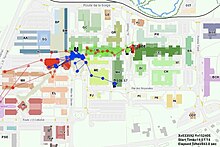
Geocaching is an outdoor recreational activity, in which participants use a Global Positioning System (GPS) receiver or mobile device and other navigational techniques to hide and seek containers, called geocaches or caches, at specific locations marked by coordinates all over the world. The first geocache was placed in 2000, and by 2023 there were over 3 million active caches worldwide.
Location-based service (LBS) is a general term denoting software services which use geographic data and information to provide services or information to users. LBS can be used in a variety of contexts, such as health, indoor object search, entertainment, work, personal life, etc. Commonly used examples of location-based services include navigation software, social networking services, location-based advertising, and tracking systems. LBS can also include mobile commerce when taking the form of coupons or advertising directed at customers based on their current location. LBS also includes personalized weather services and even location-based games.
Context awareness refers, in information and communication technologies, to a capability to take into account the situation of entities, which may be users or devices, but are not limited to those. Location is only the most obvious element of this situation. Narrowly defined for mobile devices, context awareness does thus generalize location awareness. Whereas location may determine how certain processes around a contributing device operate, context may be applied more flexibly with mobile users, especially with users of smart phones. Context awareness originated as a term from ubiquitous computing or as so-called pervasive computing which sought to deal with linking changes in the environment with computer systems, which are otherwise static. The term has also been applied to business theory in relation to contextual application design and business process management issues.
Gameplay is the specific way in which players interact with a game, and in particular with video games. Gameplay is the pattern defined through the game rules, connection between player and the game, challenges and overcoming them, and player's connection with it. Video game gameplay is distinct from graphics and audio elements. In card games, the equivalent term is play.

A mobile game is a video game that is typically played on a mobile phone. The term also refers to all games that are played on any portable device, including from mobile phone, tablet, PDA to handheld game console, portable media player or graphing calculator, with and without network availability. The earliest known game on a mobile phone was a Tetris variant on the Hagenuk MT-2000 device from 1994.

An electronic game is a game that uses electronics to create an interactive system with which a player can play. Video games are the most common form today, and for this reason the two terms are often used interchangeably. There are other common forms of electronic game including handheld electronic games, standalone systems, and exclusively non-visual products.
Locative media or location-based media (LBM) is a virtual medium of communication functionally bound to a location. The physical implementation of locative media, however, is not bound to the same location to which the content refers.

Mobile social networking is social networking where individuals with similar interests converse and connect with one another through their mobile phone and/or tablet. Much like web-based social networking, mobile social networking occurs in virtual communities.
Mscape was a mobile media gaming platform developed by Hewlett-Packard that could be used to create location-based games. The development of Mscape was discontinued on March 31, 2010.

Virtual graffiti consists of virtual or digital media applied to public locations, landmarks or surfaces. Virtual graffiti applications utilize augmented reality and ubiquitous computing to anchor virtual graffiti to physical landmarks or objects in the real world. The virtual content can then be viewed through digital devices. Virtual graffiti is aimed at delivering messaging and social multimedia content to mobile applications and devices based on the identity, location, and community of the user.
A pervasive game is one where the gaming experience is extended out into the real world, or where the fictional world in which the game takes place blends with the physical world. The "It's Alive" mobile games company described pervasive games as "games that surround you," while Montola, Stenros, and Waern's book Pervasive Games defines them as having "one or more salient features that expand the contractual magic circle of play spatially, temporally, or socially." The concept of a "magic circle" draws from the work of Johan Huizinga, who describes the boundaries of play.
Activity recognition aims to recognize the actions and goals of one or more agents from a series of observations on the agents' actions and the environmental conditions. Since the 1980s, this research field has captured the attention of several computer science communities due to its strength in providing personalized support for many different applications and its connection to many different fields of study such as medicine, human-computer interaction, or sociology.

Marmalade SDK was a cross-platform software development kit and game engine from Marmalade Technologies Limited that contains library files, samples, documentation and tools required to develop, test and deploy applications for mobile devices.
Mobile computer-supported collaborative learning may have different meanings depending on the context in which it is applied. Mobile CSCL includes any in-class and out-of-class use of handheld mobile devices such as cell phones, smart phones, and personal digital assistants (PDAs) to enable collaborative learning.

Far-Play is a software platform developed at the University of Alberta, for creating location-based, scavenger-hunt style games which use the GPS and web-connectivity features of a player's smartphone. According to the development team, "our long-term objective is to develop a general framework that supports the implementation of AARGs that are fun to play and also educational". It utilizes Layar, an augmented reality smartphone application, QR codes located at particular real-world sites, or a phone's web browser, to facilitate games which require players to be in close physical proximity to predefined "nodes". A node, referred to by the developers as a Virtual Point of Interest (vPOI), is a point in space defined by a set of map coordinates; fAR-Play uses the GPS function of a player's smartphone — or, for indoor games, which are not easily tracked by GPS satellites, specially-created QR codes— to confirm that they are adequately near a given node. Once a player is within a node's proximity, Layar's various augmented reality features can be utilized to display a range of extra content overlaid upon the physical play-space or launch another application for extra functionality.
A transreality game, sometimes written as trans-reality game, describes a type of video game or a mode of gameplay that combines playing a game in a virtual environment with game-related, physical experiences in the real world and vice versa. In this approach a player evolves and moves seamlessly through various physical and virtual stages, brought together in one unified game space. Alongside the rising trend of gamification, the application of game mechanics to tasks that are not traditionally associated with play, a transreality approach to gaming incorporates mechanics that extend over time and space, effectively playing through a players day-to-day interactions.
GeoSpy was an outdoor recreational activity which combines geographic locations and maps with photography in a location-based game. To play the game requires a camera and a mobile Global Positioning System (GPS) device.
Cluetivity is a geolocation-based and augmented reality (AR) software platform owned by Life Action Games GmbH. Founded in 2010 by a group of scavenger hunt and tech fans, Cluetivity offers both outdoor and indoor interactive games for iOS devices. The company is currently led by CEO Michael Schiemann.
A geolocation-based video game or location-based video game is a type of video game where the gameplay evolves and progresses via a player's location in the world, often attained using GPS. Most location-based video games are mobile games that make use of the mobile phone's built in GPS capability, and often have real-world map integration. One of the most recognizable location-based mobile games is Pokémon Go. Location-based (GPS) games are often conflated with augmented reality (AR) games. GPS and AR are two separate technologies which are sometimes both used in a game, like in Pokémon Go and Minecraft Earth. GPS and AR functionality largely do not depend on one another but are often used in concert. A video game may be an AR game, a location-based game, both, or neither.

Adriana de Souza e Silva is a Brazilian/American communication professor, information technologist, academic, and author. She is a professor in the Department of Communication at the North Carolina State University and Director at the Networked Mobilities Lab.








